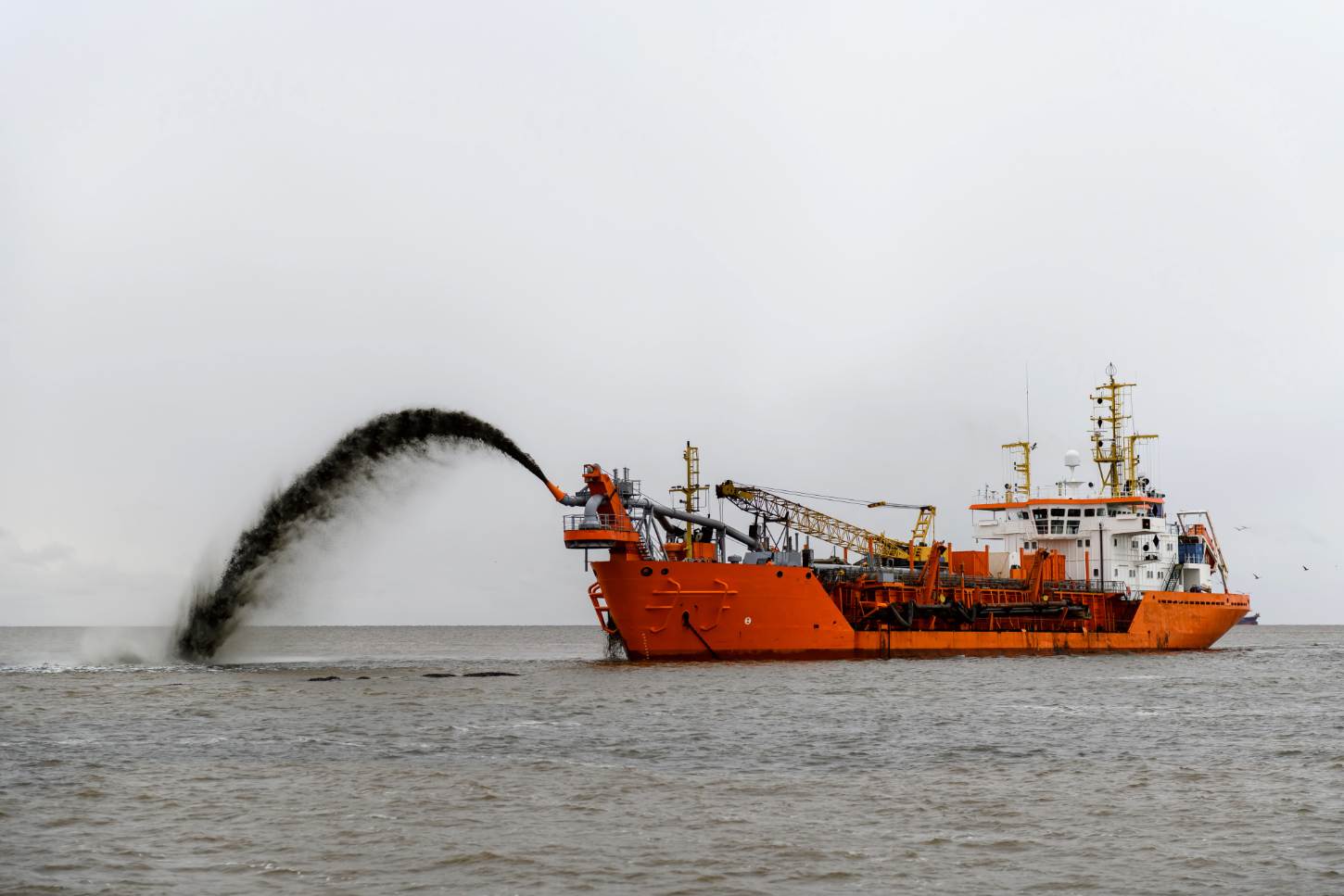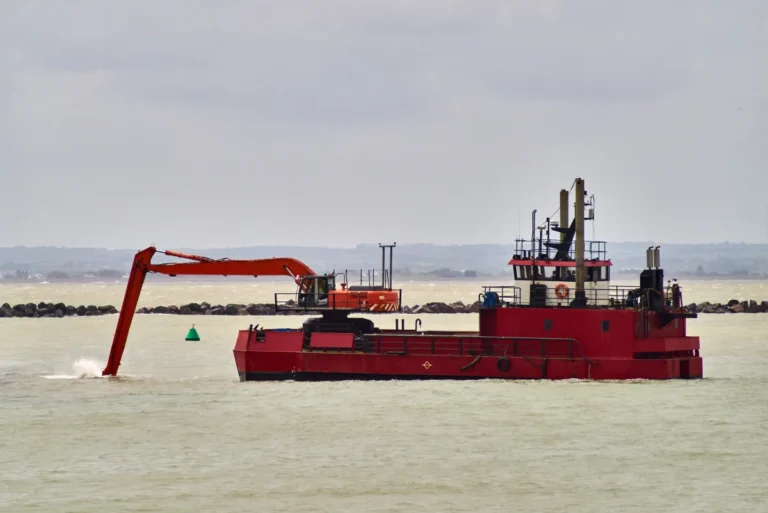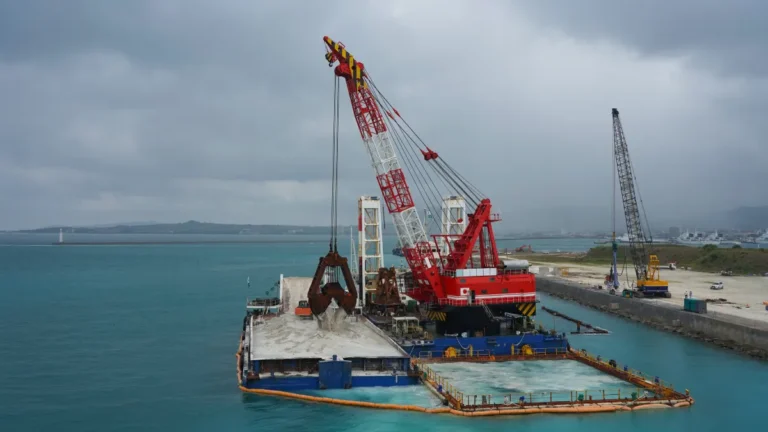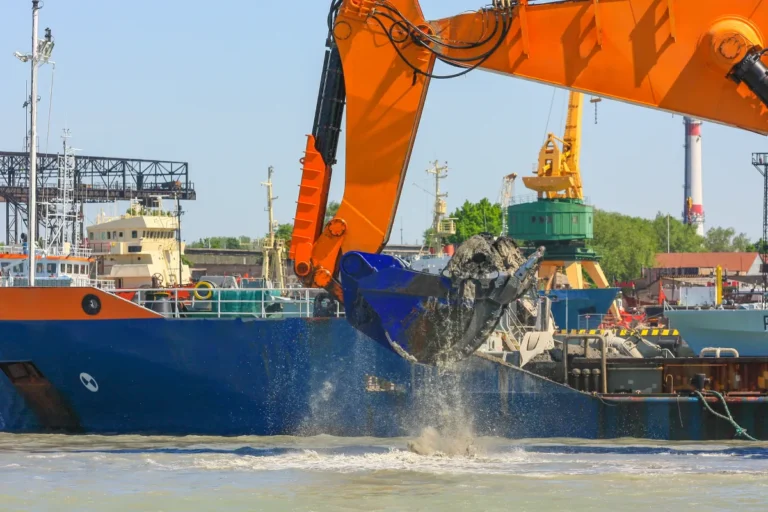Dredging plays a vital role in a wide range of industries, from maintaining navigable waterways in ports and rivers to supporting coastal protection efforts and enabling resource extraction in mining operations. By removing sediments, sand, and debris from underwater environments, dredging ensures safe ship passage, prevents flooding, restores ecosystems, and facilitates infrastructure development. As global trade expands and environmental challenges intensify, efficient and sustainable dredging solutions have become more critical than ever.
Among the various dredging technologies available, the hopper dredger stands out for its ability to perform large-scale dredging operations with remarkable speed and efficiency. A hopper dredger is a specialized vessel equipped with onboard storage compartments, known as hoppers, that allow it to dredge material and transport it over significant distances without external assistance. Two important subtypes—the trailing suction hopper dredger and the suction hopper dredger—offer distinct operational methods that cater to different project needs.
This blog compares the capabilities of hopper dredgers, including both trailing suction hopper dredgers and suction hopper dredgers, against other common types of dredging vessels. Choosing the right dredger is essential not only for operational efficiency but also for optimizing project costs and minimizing environmental impacts. Understanding these differences can help project managers, engineers, and decision-makers select the most suitable vessel for their unique dredging requirements.
What Is a Hopper Dredger?
A hopper dredger is a type of self-propelled vessel specifically designed to perform dredging activities in a highly efficient and flexible manner. Its primary function is to excavate and collect underwater materials such as sand, silt, clay, or gravel from the seabed and temporarily store them in onboard containment areas known as hoppers. Unlike stationary dredging systems, a hopper dredger can both dredge and transport the material to disposal or reclamation sites without requiring external support, making it exceptionally versatile for large-scale projects.
The basic operation of a hopper dredger involves lowering one or more suction pipes fitted with dragheads onto the seabed. As the vessel moves slowly forward, particularly in the case of a trailing suction hopper dredger, powerful pumps create suction, drawing in a mixture of sediment and water. This slurry is then transported through the suction pipes into the hopper compartments. Once the hopper is full, the vessel sails to a designated disposal area, where the material is either released through bottom doors, pumped ashore via a pipeline, or sprayed through a nozzle, depending on project requirements.
Key components of a hopper dredger include:
- Suction Pipes: Connected to dragheads that loosen and intake seabed material.
- Hoppers: Storage compartments that temporarily hold the dredged slurry.
- Discharge Systems: Mechanisms such as bottom doors, pipelines, or pumps that allow controlled release or placement of materials.
Both the suction hopper dredger, which often operates from a stationary or semi-mobile position, and the trailing suction hopper dredger, which dredges while in motion, serve vital roles in a variety of projects. Typical applications of hopper dredgers include port deepening to accommodate larger vessels, coastal maintenance to restore eroded beaches, and sand mining for construction or land reclamation purposes. Their ability to operate in open waters and handle a wide range of sediment types makes hopper dredgers an indispensable asset in modern dredging operations.
A hopper dredger is a type of self-propelled vessel specifically designed to perform dredging activities in a highly efficient and flexible manner. Its primary function is to excavate and collect underwater materials such as sand, silt, clay, or gravel from the seabed and temporarily store them in onboard containment areas known as hoppers. Unlike stationary dredging systems, a hopper dredger can both dredge and transport the material to disposal or reclamation sites without requiring external support, making it exceptionally versatile for large-scale projects.
The basic operation of a hopper dredger involves lowering one or more suction pipes fitted with dragheads onto the seabed. As the vessel moves slowly forward, particularly in the case of a trailing suction hopper dredger, powerful pumps create suction, drawing in a mixture of sediment and water. This slurry is then transported through the suction pipes into the hopper compartments. Once the hopper is full, the vessel sails to a designated disposal area, where the material is released through bottom doors, pumped ashore via a pipeline, or sprayed through a nozzle, depending on project requirements.
Key components of a hopper dredger include:
- Suction Pipes: Connected to dragheads that loosen and intake seabed material.
- Hoppers: Storage compartments that temporarily hold the dredged slurry.
- Discharge Systems: Mechanisms such as bottom doors, pipelines, or pumps that allow controlled release or placement of materials.
Both the suction hopper dredger, which often operates from a stationary or semi-mobile position, and the trailing suction hopper dredger, which dredges while in motion, serve vital roles in a variety of projects. Typical applications of hopper dredgers include port deepening to accommodate larger vessels, coastal maintenance to restore eroded beaches, and sand mining for construction or land reclamation purposes. Their ability to operate in open waters and handle a wide range of sediment types makes hopper dredgers an indispensable asset in modern dredging operations.
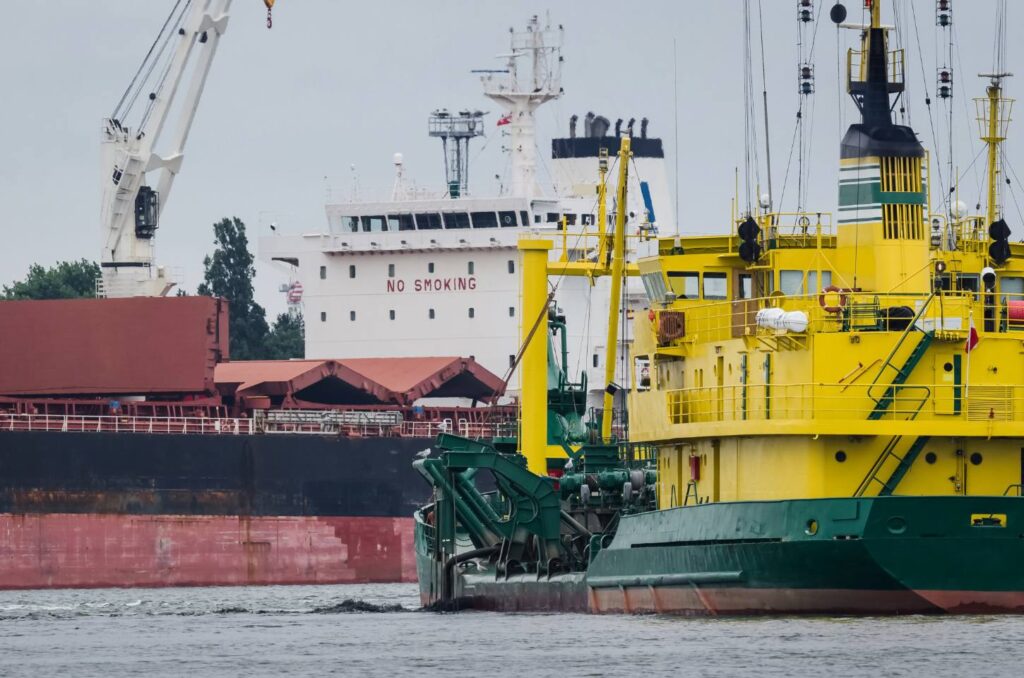
Understanding Trailing Suction Hopper Dredgers (TSHDs)
The trailing suction hopper dredger (TSHD) is a specialized type of hopper dredger designed for continuous and highly mobile dredging operations. What sets a trailing suction hopper dredger apart is its ability to dredge material while the vessel is underway, rather than working from a stationary position. This unique capability makes TSHDs ideal for large-scale projects where efficiency and speed are critical.
In operation, a trailing suction hopper dredger deploys one or more suction pipes with dragheads that rest on or are towed slightly above the seabed. As the vessel slowly moves along a predetermined path, the dragheads loosen sediment while high-capacity pumps create suction, drawing the slurry into the vessel’s hopper compartments. Unlike a stationary suction hopper dredger, which often dredges while anchored or moored, a TSHD remains in constant motion, allowing for seamless material collection across vast dredging areas.
Key advantages of a trailing suction hopper dredger include:
- Continuous Operation: By dredging while moving, TSHDs maintain high productivity levels and minimize operational downtime.
- Flexibility in Open Seas: Trailing suction hopper dredgers can operate effectively in offshore environments, where waves and currents would make stationary dredging difficult.
- Reduced Downtime: With self-contained storage and mobility, TSHDs can quickly transport dredged material to disposal or reclamation sites without the need for additional barges or support vessels.
Trailing suction hopper dredgers are especially well-suited for industries and environments such as port deepening, beach nourishment, land reclamation, and offshore sand mining. Their ability to cover extensive dredging areas quickly and efficiently makes them a preferred choice for projects that demand both high output and operational versatility. Whether working on coastal infrastructure upgrades or maintaining busy shipping channels, the trailing suction hopper dredger remains one of the most valuable assets in the global dredging fleet.
Suction Hopper Dredgers: Static Operations Explained
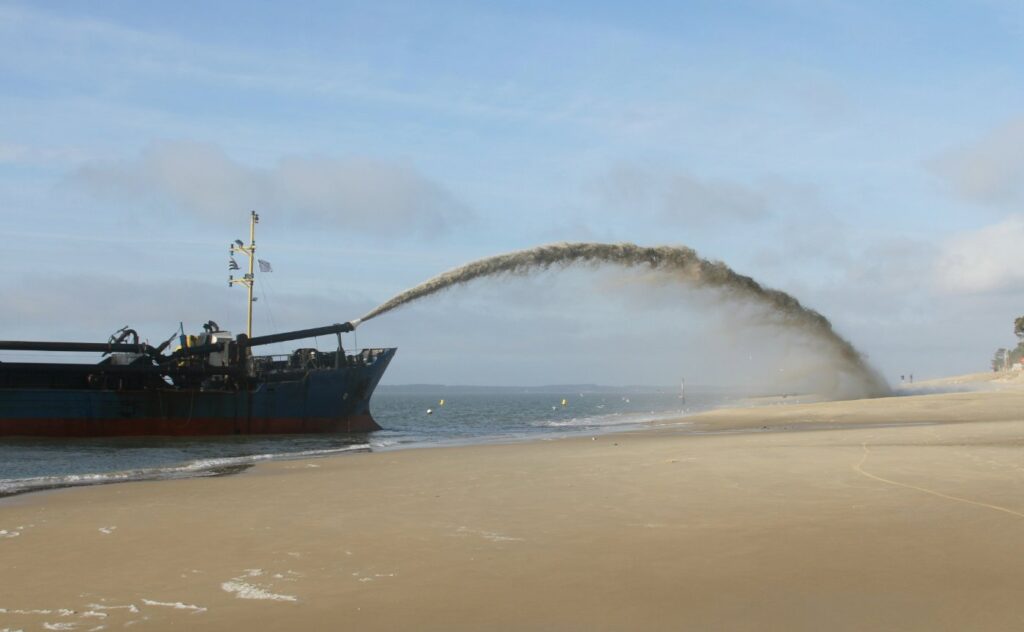
While a trailing suction hopper dredger is known for its dynamic movement during operations, a suction hopper dredger typically performs dredging from a stationary or semi-mobile position. This difference in operation style is key when selecting the right hopper dredger for specific project conditions.
A suction hopper dredger operates by lowering one or more suction pipes vertically into the seabed. At the same time, the vessel remains anchored or positioned with the help of spuds or dynamic positioning systems. The onboard pumps generate suction force, drawing a slurry mixture of sediment and water directly into the hopper. Because the vessel is not continuously moving during the dredging process, it allows for more targeted excavation and finer control over sediment removal in confined or sensitive areas.
Unlike a trailing suction hopper dredger, which excels in large, open environments, a stationary suction hopper dredger is better suited for precision dredging tasks, such as maintenance dredging in busy harbors, riverbeds, and shallow coastal zones. It can effectively remove silt, fine sand, and soft clay with minimal disturbance to surrounding structures and ecosystems.
Key advantages of a suction hopper dredger operating in static mode include:
- Greater Control: Allows for more precise sediment removal in restricted or heavily trafficked areas.
- Minimized Environmental Impact: Reduces turbidity and sediment spread during dredging activities.
- Efficient Spot Dredging: Ideal for maintaining critical navigation channels or working around port infrastructure.
Typical industries and applications for suction hopper dredgers include harbor maintenance, deepening inland waterways, and small-scale reclamation projects. When high accuracy and environmental sensitivity are required, choosing a suction hopper dredger over a trailing model or other dredging vessel types can deliver significant operational advantages.
Overview of Other Common Dredging Vessels
While the hopper dredger, including the trailing suction hopper dredger and suction hopper dredger, offers versatile solutions for many dredging projects, there are other types of dredging vessels better suited to specific applications. Understanding the features and limitations of these vessels helps in making a fully informed decision.
Cutter Suction Dredger (CSD)
A Cutter Suction Dredger uses a rotating cutter head to loosen compacted sediments, rocks, or clay before suctioning the material through a pipeline. Unlike a hopper dredger, a CSD remains stationary, anchored with spuds while operating.
- Pros: Highly effective in tough soils; capable of cutting through rock and hard-packed materials.
- Cons: Requires support vessels and pipeline infrastructure; less mobile.
- Best for: land reclamation, trench digging, and dredging hard materials.
Bucket Dredger
Bucket dredgers use mechanical buckets attached to a chain or arm to scoop up material from the seabed. This traditional method is highly accurate but slower than modern suction-based systems.
- Pros: Excellent for precision excavation and archaeological dredging.
- Cons: Labor-intensive and slow; limited operational depth.
- Best for: Small harbors, canals, and urban waterfront restoration.
Backhoe Dredger
Operating much like a land-based excavator, a backhoe dredger is mounted on a barge and uses an articulated arm with a bucket to excavate sediment.
- Pros: Extreme precision; capable of handling very dense materials.
- Cons: Limited production rates; needs frequent repositioning.
- Best for: Quay wall construction, marina building, and dredging near existing structures.
Grab/Clamshell Dredger
These vessels use a clamshell or grab bucket suspended from a crane to scoop up loose materials.
- Pros: Flexible and effective for working in confined or narrow spaces.
- Cons: Not suitable for compacted or rocky soils.
- Best for: Maintenance dredging in ports, rivers, and docks.
Hopper Dredger vs. Other Vessels: Key Comparison Factors
Choosing between a hopper dredger and other dredging vessels requires a clear understanding of the operational demands of your project. Each type of vessel offers distinct strengths and limitations, depending on factors such as project size, sediment type, environmental conditions, and budget. Here’s a detailed comparison across key factors:
Mobility and Operational Flexibility
A major advantage of the trailing suction hopper dredger is its ability to dredge while moving. This continuous operation enables efficient material collection over large areas, without the need for frequent repositioning. In contrast, cutter suction or bucket dredgers are largely stationary during operations. For projects covering wide expanses, the hopper dredger offers superior mobility and reduced downtime.
Material Type and Dredging Depth
When dealing with loose sediments like sand, silt, and soft clay, both suction hopper dredgers and trailing suction hopper dredgers excel. However, for dredging compacted soils or hard rock, mechanical dredgers such as cutter suction dredgers or backhoe dredgers may be more suitable due to their aggressive excavation capabilities.
Project Scale and Duration
Hopper dredgers are ideal for medium- to large-scale projects, such as port expansions, coastal maintenance, and land reclamation. Their onboard hopper storage enables them to dredge continuously and transport sediment to distant disposal sites efficiently. Smaller projects that require precise, localized dredging might be better served by backhoe or clamshell dredgers.
Disposal Methods and Distance
A hopper dredger has a significant advantage in that it can transport and dispose of dredged material without relying on separate barges. After filling the hopper, the vessel sails to a designated site and releases material through bottom doors or pumps it ashore. In contrast, other dredgers often require additional transportation logistics, which increases complexity and cost.
Environmental Impact
Both the trailing suction hopper dredger and suction hopper dredger are designed to minimize turbidity and environmental disruption, especially when operated with precision dragheads and controlled pumping systems. Mechanical dredgers, such as bucket or grab dredgers, however, can cause more sediment resuspension and may require additional mitigation measures, especially in sensitive ecosystems.
Advantages of Choosing a Hopper Dredger
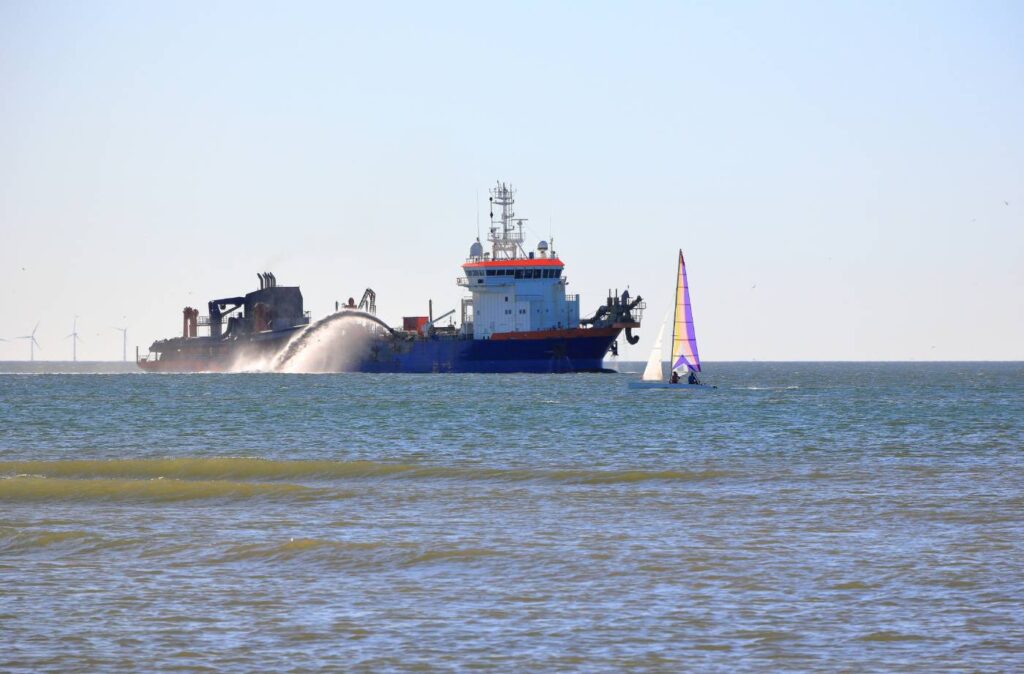
When evaluating dredging solutions for large-scale or high-demand projects, a hopper dredger often stands out as the most efficient and cost-effective choice. Whether opting for a trailing suction hopper dredger or a suction hopper dredger, the benefits of using this vessel type are substantial and wide-ranging.
Faster Operations Over Wide Areas
One of the primary advantages of a hopper dredger is its ability to cover large dredging zones quickly. Thanks to continuous suction and movement, particularly in trailing suction hopper dredgers, operators can maintain steady production rates without frequent stops or repositioning. This results in shorter project timelines and reduced overall costs.
Self-Contained Sediment Transport
Unlike mechanical dredging vessels that rely on barges for material transport, a hopper dredger carries dredged materials onboard in its hopper compartments. This eliminates the need for additional logistics, streamlining operations, and providing flexibility in choosing disposal or reclamation sites.
Versatility for Maintenance and Capital Dredging
Whether performing port maintenance, deepening shipping lanes, reclaiming land, or nourishing beaches, hopper dredgers adapt easily to different dredging scopes. A suction hopper dredger is particularly effective for precision maintenance work, while a trailing suction hopper dredger can manage high-volume capital projects with ease.
Lower Manpower and Support Requirements
Because a hopper dredger is largely self-sufficient, handling both excavation and transport, it requires fewer supporting vessels and operational crews compared to mechanical dredging systems. This reduction in workforce not only decreases project costs but also simplifies coordination and risk management.
Enhanced Environmental Control
Modern trailing suction hopper dredgers and suction hopper dredgers are equipped with advanced dragheads, environmental monitoring systems, and controlled discharge options. This allows operators to control turbidity, accurately manage sediment placement, and comply with stringent environmental regulations during dredging operations.
When a Hopper Dredger Might Not Be the Best Fit
While a hopper dredger, including both trailing suction hopper dredgers and suction hopper dredgers, offers impressive versatility and efficiency, there are certain project conditions where it may not be the optimal choice. Understanding these limitations ensures better project planning and resource allocation.
Highly Compacted or Rocky Materials
If the dredging area contains highly compacted soils, boulders, or hard rock, a hopper dredger might struggle to achieve effective material removal. Mechanical dredgers, such as cutter suction dredgers or backhoe dredgers, are better equipped to handle tough seabed conditions. The suction systems of a trailing suction hopper dredger are optimized for loose to moderately compacted materials but may underperform against hardened geological formations.
Confined or Shallow Worksites
Projects in extremely confined spaces, narrow rivers, or small harbors can present maneuverability challenges for larger hopper dredgers. In these situations, more compact vessels like clamshell dredgers, backhoe dredgers, or small cutter-suction dredgers offer greater precision and access, reducing the risk of damage to nearby infrastructure.
Projects Requiring Ultra-High Precision
While a suction hopper dredger can perform spot dredging with reasonable accuracy, mechanical dredgers still excel when extremely precise material removal is required. For example, dredging near existing quay walls, underwater pipelines, or sensitive marine structures may demand the pinpoint control that backhoes or grab dredgers deliver.
Limited Project Budgets for Capital-Intensive Equipment
Deploying a modern trailing suction hopper dredger represents a significant capital investment. For small-scale or low-budget projects with minimal dredging volumes, mechanical dredging methods offer a more cost-effective solution, as they avoid the higher mobilization and operational costs associated with large hopper dredgers.
Tips for Selecting the Right Dredging Vessel for Your Project
Choosing between a hopper dredger, a trailing suction hopper dredger, a suction hopper dredger, or another type of dredging vessel requires careful evaluation of project-specific factors. Making the right selection can dramatically improve operational efficiency, project timelines, and environmental outcomes.
Analyze Sediment Type and Project Location
The type of sediment you need to dredge is one of the most important considerations. A hopper dredger excels at removing loose to medium-compact materials, such as sand, silt, and soft clay. For rocky or highly compacted beds, mechanical dredging vessels may be a better option. Additionally, assess the environmental conditions—trailing suction hopper dredgers are better equipped for open-sea operations, while suction hopper dredgers work well in sheltered or confined waters.
Assess Access and Disposal Site Proximity
If dredged material needs to be transported over long distances to disposal or reclamation sites, a hopper dredger offers a clear advantage. Its onboard storage minimizes the need for barges and allows for efficient delivery of dredged material, especially when using a trailing suction hopper dredger for high-volume operations.
Consider Local Regulations and Environmental Guidelines
Many regions have strict environmental regulations governing turbidity, noise pollution, and the placement of sediments. Modern suction hopper dredgers and trailing suction hopper dredgers offer enhanced environmental control features, such as real-time turbidity monitoring and precise sediment discharge systems, making them compliant choices for environmentally sensitive projects.
Weigh Operational Costs vs. Project Outcomes
Although the mobilization and operation of a hopper dredger can be more expensive upfront, its speed, efficiency, and reduced support requirements often lead to lower overall project costs in the long term. Weigh the total lifecycle costs of vessel deployment against project needs to make the most cost-effective decision.
Conclusion
Selecting the right dredging vessel is essential to ensuring the success of your project, whether you are managing a port expansion, coastal restoration, or land reclamation. A hopper dredger, whether operating as a trailing suction hopper dredger for continuous, large-area operations or a suction hopper dredger for precise, static dredging, offers significant advantages in mobility, efficiency, and environmental management. However, understanding the unique requirements of your site, such as the type of sediment, project scale, and local environmental regulations, is key to making the best choice. By carefully evaluating these factors, project managers can confidently select the ideal dredging solution to maximize results and minimize costs.


